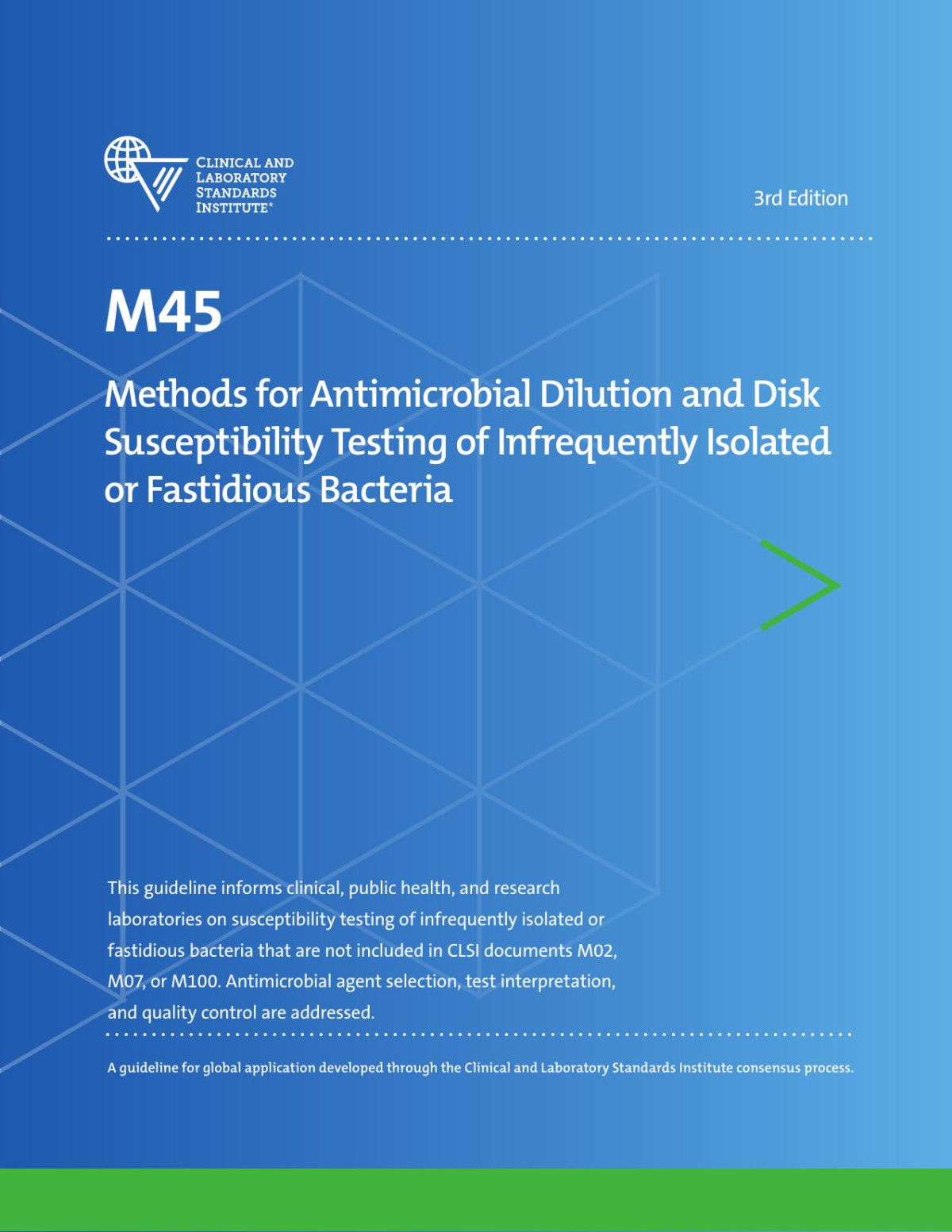

Most ebook files are in PDF format, so you can easily read them using various software such as Foxit Reader or directly on the Google Chrome browser.
Some ebook files are released by publishers in other formats such as .awz, .mobi, .epub, .fb2, etc. You may need to install specific software to read these formats on mobile/PC, such as Calibre.
Please read the tutorial at this link. https://ebooknice.com/page/post?id=faq
We offer FREE conversion to the popular formats you request; however, this may take some time. Therefore, right after payment, please email us, and we will try to provide the service as quickly as possible.
For some exceptional file formats or broken links (if any), please refrain from opening any disputes. Instead, email us first, and we will try to assist within a maximum of 6 hours.
EbookNice Team

Status:
Available5.0
41 reviews
ISBN 10: 1562389173
ISBN 13: 978-1562389178
Author: Clinical and Laboratory Standards Institute
CLSI M45 (3rd ed.) is the go-to authoritative guide for performing antimicrobial susceptibility testing on rare or difficult-to-grow bacteria—detailing all method types, QC practices, interpretive criteria, and species-specific guidance, making it essential in clinical and reference lab settings.
Chapter 1: Introduction.
1.1 Scope.
1.2 Background
1.3 Standard Precautions.
1.4 Terminology.
Chapter 2: Indications for Performing Susceptibility Tests.
Chapter 3: Methods for Antimicrobial Susceptibility Testing of Infrequently Isolated or Fastidious Bacteria
3.1 Selection of Antimicrobial Agents.
3.2 Dilution Antimicrobial Susceptibility Testing of Infrequently Isolated or Fastidious Bacteria.
3.3 Antimicrobial Disk Diffusion Susceptibility Testing of Infrequently Isolated or Fastidious Bacteria...
3.4 Detection of Resistance to Some B-Lactams by a Direct ẞ-Lactamase Test.
3.5 Therapy-Related Comments.
Chapter 4: Quality System Essentials for Antimicrobial Susceptibility Testing of Infrequently Isolated or Fastidious Bacteria.
4.1 Quality Control
4.2 Minimum Laboratory Requirements for Testing Infrequently Isolated or Fastidious Bacteria.
Information and Interpretive Criteria for Susceptibility Testing
Table 1. Abiotrophia spp. and Granulicatella spp. (Formerly Known as Nutritionally Deficient or Nutritionally Variant Streptococci)
Table 2. Aerococcus spp.
Table 3. Aeromonas spp. (Includes Members of Aeromonas caviae Complex, Aeromonas hydrophila Complex, and Aeromonas veronii Complex).
Table 4. Bacillus spp. (Not Bacillus anthracis) and Related Genera..
Table 5. Campylobacter jejuni/coli..
Table 6. Corynebacterium spp. (Including Corynebacterium diphtheriae) and Related Coryneform Genera
Table 7. Erysipelothrix rhusiopathiae
Table 8. Gemella spp.
Table 9. HACEK Group: Aggregatibacter spp., Cardiobacterium spp., Eikenella corrodens, and Kingella spp.
Table 10. Helicobacter pylori.
Table 11. Lactobacillus spp.
Table 12. Lactococcus spp.
Table 13. Leuconostoc spp.
Table 14. Listeria monocytogenes
Table 15. Micrococcus spp.
Table 16. Moraxella catarrhalis.
Table 17. Pasteurella spp.
Table 18. Pediococcus spp.
Table 19. Rothia mucilaginosa
Table 20. Vibrio spp. (Including Vibrio cholerae).
Table 21. Potential Bacterial Agents of Bioterrorism: Bacillus anthracis, Yersinia pestis, Burkholderia mallei, Burkholderia pseudomallei, Francisella tularensis, and Brucella spp..
Table 22. Summary of Testing Conditions and Quality Control Recommendations for Infrequently Isolated or Fastidious Bacteria
Table 23A. MIC: Quality Control Ranges for Nonfastidious Organisms (Unsupplemented Cation-Adjusted Mueller-Hinton Broth).
Table 23B. MIC: Quality Control Ranges for Broth Microdilution Methods (Cation-Adjusted Mueller-Hinton Broth With Lysed Horse Blood [2.5% to 5% v/v]).
Table 23C. MIC: Quality Control Ranges for Campylobacter jejuni (Broth Microdilution Method) (Cation-Adjusted Mueller-Hinton Broth With Lysed Horse Blood [2.5% to 5% v/v])
Table 23D. MIC: Quality Control Ranges for Helicobacter pylori (Agar Dilution Methods) (Mueller-Hinton Agar With Aged [≥2-Week-Old] Sheep Blood)
Table 23E. MIC: Quality Control Ranges for Broth Microdilution Method (Cation-Adjusted Mueller-Hinton Broth +2% Defined Growth Supplement)
Table 23F. MIC: Quality Control Ranges for Broth Microdilution Methods (Brucella Broth Without Supplements Adjusted to pH 7.1 ±0.1).
Table 24A. Disk Diffusion: Quality Control Ranges for Nonfastidious Organisms (Unsupplemented Mueller-Hinton Medium)
Table 24B. Disk Diffusion: Quality Control Ranges for Fastidious Organisms (Mueller-Hinton Medium With 5% Sheep Blood).
Glossary I (Part 1). B-Lactams: Class and Subclass Designation and Generic Name..
Glossary I (Part 2). Non-ẞ-Lactams: Class and Subclass Designation and Generic Name.
Glossary II. Abbreviations/Routes of Administration/Drug Class for Antimicrobial Agents Listed in CLSI Document M100-S25
Glossary III. List of Identical Abbreviations Used for More Than One Antimicrobial Agent in US Diagnostic Products.
Chapter 5: Conclusion.
Chapter 6: Supplemental Information.
References..
Additional Resources
The Quality Management System Approach.
Related CLSI Reference Materials
mic method for antimicrobial activity
what is antimicrobial solution
isolation methods - quantitative dilution of bacteria
antimicrobial methods
dilution media
Tags: Clinical and Laboratory Standards Institute, M45 Methods, Antimicrobial Dilution, Disk Susceptibility